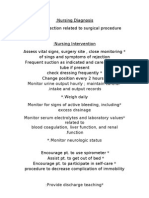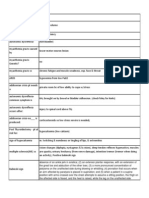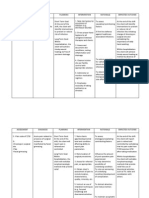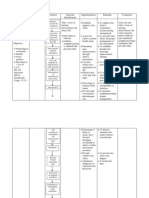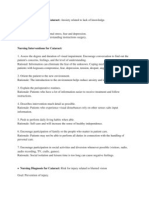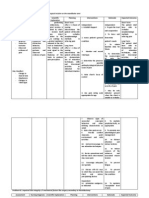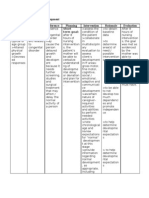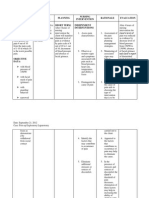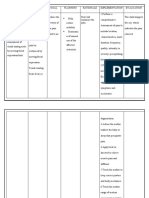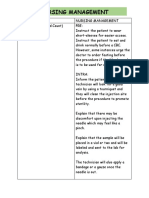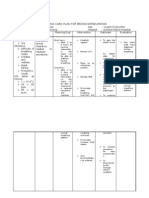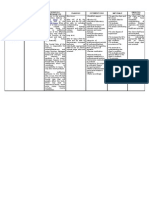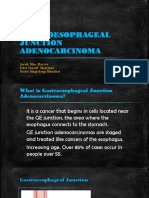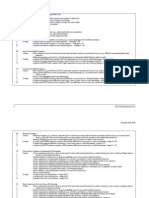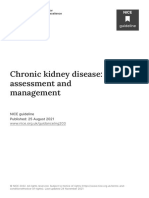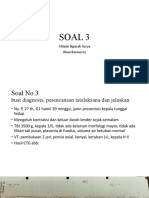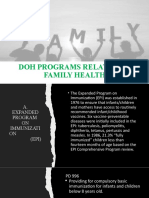NCPs For Parotidectomy
NCPs For Parotidectomy
Uploaded by
Carla ManalotoCopyright:
Available Formats
NCPs For Parotidectomy
NCPs For Parotidectomy
Uploaded by
Carla ManalotoOriginal Title
Copyright
Available Formats
Share this document
Did you find this document useful?
Is this content inappropriate?
Copyright:
Available Formats
NCPs For Parotidectomy
NCPs For Parotidectomy
Uploaded by
Carla ManalotoCopyright:
Available Formats
Problem #1: Acute Pain related to presence of surgical incision on the mandibular area Assessment S> O> the
patient manifested: - Guarding behavior - Expressive Behavior - Distraction behavior - Protective Gestures - Observed evidence of pain Nursing Diagnosis Acute Pain related to presence of surgical incision on the mandibular area as evidenced by guarding, expressive and distraction behavior, protective gestures and observed evidence of pain Scientific Explanation In performing Parotidectomy, surgical incision is expeted. By which, the incision itself causes direct irritation to the nerve endings by chemical mediators released at the site such as bradykinin. This irritation will send signal to the cortex and thalamus of the brain to produce pain perception. Planning Short Term: After 2 -4 hours of nursing interventions the patient will be able to verbalize nonpharmalogic methods in relieving pain Long Term: After 2 4 days of nursing interventions the patient will be able to demonstrate use of relaxation techniques, skills and diversional activities as indicated for individual situation Interventions Rationale Expected Outcome
Short Term: Independent: Independent: The patient shall 1. Establish Rapport 1. To gain the trust have able to verbalize and cooperation nonpharmalogic methods in relieving pain 2. Assess patient s general 2. To know and condition determine Long Term: The patient shall patient s needs have able to demonstrate use of relaxation 3. To obtain techniques, skills baseline data for and diversional future activities as indicated for 4. To determine individual situation the source/origin of pain for necessary interventions
3.
Monitor and record
Vital Signs 4. Determine the presence of possible pathophysiological/physical cause of pain
May Manifest: - Change in muscle tone - Diaphoresis - Changes in Vitals Signs
5. Note client s locus of 5. Individual s with external locus of control control may take little or no responsibility for pain management
6. Use pain rating scale 6. To evaluate the appropriate for age. severity of pain 7. Observe signs of nonverbal cues/pain behaviors and other defining characteristics as noted 8. Note when pain occurs 7. May be only indicator present when the client is unable to verbalize
8. To mediate prophylactically, as appropriate
9. Provide comfort 9. To promote non measures, quiet pharmalogical pain environment and calm management activities 10. Instruct/encourage to 10. to distract use relaxation techniques attention and reduce tentsion 11. Review procedures and 11. to reduce tell the client when treated concern of the may cause pain unknown and associated muscle tension 12. Encourage adequate rest periods 12. To prevent fatigue
13. Discuss with SO ways 13. To prevent in which they can assist the reoccurrence of client and reduce the condition
precipitating factors Dependent: 14. Administer analgesics, 14. To maintain acceptable level as indicated of pain.
Problem #2: Impaired Skin Integrity r/t mechanical factors like surgery secondary to Parotidectomy Assessment S- O>patient manifested: >post-operative incision near at the side of the ear down to the neck patient may manifest: >disruption of skin surface and layers >invasion of body structures >presence of edema, tenderness, redness, and discharges >altered sensation Nursing Diagnosis Impaired Skin Integrity r/t mechanical factors like surgery secondary to Parotidectomy Scientific Explanation Surgical incision of the incision near at the side of the ear down to the neck secondary to parotidectomy brings about the disruption of skin layers, altering its normal structure, making it vulnerable to pain upon any untoward movement and possible entry of foreign microorganisms. Planning Short-term: After 2-3h of nursing interventions, the patient will participate in preventive measures and treatment regimen. Long-term: After 3 days of nursing interventions, the patient will demonstrate behaviors to promote healing and to prevent further tissue injury. 4. provide care AM Interventions 1. establish rapport 2. assess patient s condition Rationale Expected Outcome 1. to gain trust Short-term: of the patient The patient shall have able to in 2. to note any participate abnormaliti preventive and es within measures treatment regimen. the patient Long-term: 3. to obtain The patient shall baseline have demonstrated data behaviors to promote healing and to prevent 4. to promote further tissue injury. comfort and prevent contaminati on 5. to prevent infection
3. monitor & recorded v/s
5. keep the area clean and dry 6. remove wet lines promptly 7. instruct the SO/patient to eat foods rich in CHONs such as steamed fish and legumes when patient is on
6. to provide comfort
7. for
faster
DAT diet
wound healing 8. to obtain pharmacolo gical benefits 9. to prevent excessive fluid loss
8. encourage SO/patient to follow medical regimens 9. regulate IVF
10. due given
meds
10. to provide pharmacolo gical pain managemen t 11. to satisfy the needs of the patient
11. attend needs of the patient
Problem #3: Disturbed sensory perception related to altered status of sense organ as evidenced by ingestion of anesthesia secondary to parotidectomy Assessment Nursing Diagnosis Disturbed sensory perception related to altered status of sense organ as evidenced by ingestion of anesthesia secondary to parotidectomy Scientific Explanation General anesthesia refers to inhibition of sensory, motor and sympathetic nerve transmission at the level of the brain, resulting in unconsciousness and lack of sensation. Change in the amount or patterning of incoming stimuli accompanied by diminished, exaggerated, distorted, or impaired response to such stimuli Planning Short term: After 2- 4 hours of nursing interventions the patient will be able to use resources effectively and appropriately Long term: After 2 4 days of nursing interventions the patient will be able to be free of injury Interventions Rationale Expected Outcome
S> O> The patiend manifested: - Change in response to stimuli - Restlessness - Changed in sensory acuity - Altered sense of balance
Short term: Independent: Independent: The patient shall 1. Establish Rapport 1. To gain the trust have able to use and cooperation resources effectively and 2. Assess patient s 2. To know and appropriately general condition determine patient s needs Long term: The patient shall 3. Monitor and 3. To obtain baseline have able to be free record Vital Signs data for future of injury 4. To assess client s 4. identify client sensation status with condition that can affect sensing, interpreting stimuli 5. To note whether 5. Determine response is response to painful appropriate to stimuli stimulus, immediate or delayed 6. To relax the patient giving calm 6. Provide safety environment measures as needed 7. To determine
7. Describe where affected areas of the body are when moving client
necessary intervention when affected area is located 8. Enhances commitment to abd continuation of plan, optimizing outcomes
8. Provide explanations of the plan care with the client, involving SO as much as possible
Dependent: Dependent 9. To identify 9. Monitor drug medications with regimen effects or drug interactions that may cause/exacerbate perceptual problems 10. Discuss drug regimen, noting possible toxic side effects of both prescription and OTC drugs 10. Prompt recognition of side effects allows for timely intervention/change in drug regimen
Problem #5: Risk for Infection related to surgical incision near the at side of the ear down to the neck secondary to parotidectomy Assessment S> O>the patient manifested: Surgical incision sited at the side of the ear down to the neck Tissue destruction With increased exposure to environmen tal pathogens Nursing Diagnosis Risk for Infection related to surgical incision near the at side of the ear down to the neck secondary to parotidectomy Scientific Explanation With the presence of surgical incision leading to tissue damage, it can lead to certain amounts that can expose a part of the incision site making the microorganisms open to lead inside the tissue or organ. This then gives potential risk to the patient leading to growth of microorganisms and then tangles with the body s defense and immune stimulation, then after all complications, it then leads to infection. Planning Short term: After 2 3 hours of nursing interventions the patient will be able to verbalize understanding of individual s causative/risk factors Expected Outcome Short term: Independent: Independent: The patient shall 1. Establish Rapport 1. To gain the trust have able to and cooperation verbalize understanding of 2. Assess patient s 2. To know and individual s general condition determine patient s causative/risk needs factors Interventions Rationale
3. Monitor and 3. To obtain baseline Long term: record Vital Signs data for future The patient shall Long term: have able to achieve After 2 3 days of 4. Note risk factors 4. For occurrence of timely wound nursing infection healing interventions the patient will be able 5. Observe for 5. To assess and to achieve timely localized signs of locate the possible wound healing infection at insertion origin of infection sites of invasive lines, sutures, surgical incisions/wounds 6. Stress proper hand hygiene by all caregivers between therapy 7. Provide isolation, indicated 6. To give first line of defense when giving care to the client
for 7. Reduces risk of as cross contamination
8. Maintain sterile 8. To prevent technique for all infection or invasive procedures contamination of the wound 9. Change surgical/other wound dressings, as indicated 9. For proper wound hygiene to fasten the healing period prevent potential grown of pathogens 10. To meet the metabolic need of the client for better wound healing and resistance to infection
10. Review individual nutritional needs, appropriate exercise program and need for rest
Problem #4: Risk for Imbalanced Body Temperature related to post anesthesia effect
Assessment
Nursing Diagnosis Risk for Imbalanced Body Temperature related to post anesthesia effect
S> O>the patient manifested: post operational anesthesia effect altered metabolic rate
>may manifest hyperthermia hypothermia
Scientific Explanation In susceptible individuals, these drugs can induce a drastic and uncontrolled increase in skeletal muscle oxidative metabolism, which overwhelms the body's capacity to supply oxygen, remove carbon dioxide, and regulate body temperature, eventually leading to circulatory collapse and death if not treated quickly. Malignant hyperthermia (MH) or malignant hyperpyrexia is a rare life-threatening condition that is usually triggered by exposure to certain drugs used for general anesthesia; specifically, the
Planning Short Term: After 2 4 hours of nursing interventions the patient will be able to maintain body temperature within normal range Long Term: After 2 4 days of nursing interventions the patient will be able to demonstrate behaviors monitoring and maintaining appropriate body temperature
Interventions
Rationale
Expected Outcome
Independent: 1. Establish Rapport
2. Assess patient s general condition
3. Monitor and record Vital Signs 4. Determine if present illness/condition results to exposure to environmental factors, surgery trauma 5. Assess nutritional status
Independent: Short Term: 1. To gain the trust The patient shall have able to and cooperation maintain body 2. To know and temperature within determine patient s normal range needs Long Term: 3. To obtain The patient Shall baseline data for have able to demonstrate future behaviors monitoring and 4. Helps to maintaining determine the appropriate body scope of temperature intervention that may be needed
6. Monitor/maintain
5. To determine metabolism effect on the body temperature and to identify foods or nutrient deficits that affect
volatile anesthetic agents and the neuromuscular blocking agent, succinylcholine. In susceptible individuals, these drugs can induce a drastic and uncontrolled increase in skeletal muscle oxidative metabolism, which overwhelms the body's capacity to supply oxygen, remove carbon dioxide, and regulate body temperature, eventually leading to circulatory collapse and death if not treated quickly.
comfortable ambient environment 7. Monitor core body temperature
metabolism 6. To relax the patient for normal core temperature monitoring 7. For assessment and to establish necessary interventions 8. To prevent reoccurrence
8. Discuss potential problem/individual risk factors with client 9. Instruct in appropriate self care measures
9. To be self reliant and knowledgeable in existing condition
You might also like
- Preoperative and Post Liver Transplant Nursing Care PlanDocument5 pagesPreoperative and Post Liver Transplant Nursing Care PlanOctoober67% (6)
- NCLEX-PN Disease and DisorderDocument3 pagesNCLEX-PN Disease and Disorderstring4480% (5)
- Nursing Care Plan For AppendectomyDocument5 pagesNursing Care Plan For Appendectomyvanessajane0989% (45)
- 4 Congenital Hip Dysplasia Nursing Care PlansDocument4 pages4 Congenital Hip Dysplasia Nursing Care PlansItstineeNo ratings yet
- Nursing Care Plan: Nursing Diagnosis Goal Interventions (3) (Reference) Rationale (Reference) EvaluationDocument4 pagesNursing Care Plan: Nursing Diagnosis Goal Interventions (3) (Reference) Rationale (Reference) EvaluationJulvica HeuwNo ratings yet
- Cholecystectomy Nursing Care Plan: Risk For InfectionDocument1 pageCholecystectomy Nursing Care Plan: Risk For InfectionBesael BaccolNo ratings yet
- Nursing Students Peritonitis Care PlanDocument2 pagesNursing Students Peritonitis Care PlanJide Manuel100% (2)
- Dermatomyositis NCPDocument3 pagesDermatomyositis NCPMakki MarcosNo ratings yet
- Nursingcrib Com NURSING CARE PLAN Hepatitis ADocument2 pagesNursingcrib Com NURSING CARE PLAN Hepatitis APravesh Verma100% (1)
- Discharge PlanDocument5 pagesDischarge PlanRaymond BasiloniaNo ratings yet
- Nursing Care Plan: Cues Nursing Diagnosis Definitio N Goal and Objectives Nursing Interventions Rationale Evaluati ONDocument5 pagesNursing Care Plan: Cues Nursing Diagnosis Definitio N Goal and Objectives Nursing Interventions Rationale Evaluati ONOphelia Ross Omaña TutanesNo ratings yet
- Otitis Media NCPDocument2 pagesOtitis Media NCProneln100% (9)
- Anxiety Related To Stress HspitaiztionDocument1 pageAnxiety Related To Stress HspitaiztionEunice Lan Sandoval Ardiente100% (3)
- NCP Head InjuryDocument3 pagesNCP Head InjuryEdelou Alegria Jumawan67% (3)
- Nursing Diagnosis For CataractDocument3 pagesNursing Diagnosis For CataractZainul HazwanNo ratings yet
- Nursing Care Plan On CystoceleDocument7 pagesNursing Care Plan On Cystoceleleo100% (1)
- Pink Panther - Diabetes Management - Chapter 5Document6 pagesPink Panther - Diabetes Management - Chapter 5jennmoyerNo ratings yet
- NCPs For ParotidectomyDocument8 pagesNCPs For ParotidectomyAcohCChao100% (1)
- NCP CholangitisDocument4 pagesNCP CholangitisJanica C. Bayaua100% (1)
- NCP Actual and PotentialDocument4 pagesNCP Actual and PotentialKristian Karl Bautista Kiw-isNo ratings yet
- SWCP - NCPDocument12 pagesSWCP - NCPYvonne Niña ArantonNo ratings yet
- Thyroidectomy NCPDocument1 pageThyroidectomy NCPkzbreakerrNo ratings yet
- NCP Close Complete Fracture Knowledge DeficitDocument2 pagesNCP Close Complete Fracture Knowledge DeficitArt Christian Ramos0% (1)
- Biopsy: Assessment Diagnosis Planning Intervention Rationale EvaluationDocument5 pagesBiopsy: Assessment Diagnosis Planning Intervention Rationale EvaluationDan HizonNo ratings yet
- Delayed Growth and Development Assessment N.Diagnosis Inference Planning Intervention Rationale EvaluationDocument2 pagesDelayed Growth and Development Assessment N.Diagnosis Inference Planning Intervention Rationale Evaluationkreny10No ratings yet
- Legal Psychiatric Nursing Issues Commitment IssuesDocument17 pagesLegal Psychiatric Nursing Issues Commitment IssuesBrandon Arete100% (1)
- NCPDocument3 pagesNCPbjhilario100% (1)
- Case Study NCP ActualDocument3 pagesCase Study NCP Actualdhamy florNo ratings yet
- Chicken Pox N C P BY BHERU LALDocument2 pagesChicken Pox N C P BY BHERU LALBheru Lal100% (1)
- Case Presntation NURSING CARE PLANDocument6 pagesCase Presntation NURSING CARE PLANmadhurima kunduNo ratings yet
- Assessment Nursing Diagnosis Planning Nursing Intervention Rationale EvaluationDocument3 pagesAssessment Nursing Diagnosis Planning Nursing Intervention Rationale EvaluationMikhaelEarlSantosTacordaNo ratings yet
- Nursing Care Plan Orthopedic Philipine CenterDocument4 pagesNursing Care Plan Orthopedic Philipine CenterAnonymous NZTQVgjaNo ratings yet
- Er NCPDocument9 pagesEr NCPEden Marie FranciscoNo ratings yet
- Teaching Plan: Involution (Bubble He)Document4 pagesTeaching Plan: Involution (Bubble He)Pamela BagabaldoNo ratings yet
- NCPDocument7 pagesNCPJo Chiko FlorendoNo ratings yet
- Anatomy and Physiology of AppendixDocument4 pagesAnatomy and Physiology of AppendixKandilanapumapaso SapusongbawattaoNo ratings yet
- NCP - Anxiety Hypertension)Document3 pagesNCP - Anxiety Hypertension)Jaja Jaime100% (2)
- Care Plan For Septic ArthritisDocument5 pagesCare Plan For Septic ArthritisokaciaNo ratings yet
- CHAPTER 5 Nursing Care PlanDocument5 pagesCHAPTER 5 Nursing Care PlanMiguelito Galagar GultianoNo ratings yet
- Nursing Care Plan - HyperDocument4 pagesNursing Care Plan - HyperJennalyn Casapao100% (1)
- Nursing Drug StudyDocument12 pagesNursing Drug StudyJoshkorro Geronimo100% (2)
- NSO - Adam's Forward Bend TestDocument2 pagesNSO - Adam's Forward Bend TestMaha AmilNo ratings yet
- Nursing ManagementDocument19 pagesNursing ManagementAjie ZamNo ratings yet
- Health Deficit: Presence of PediculosisDocument2 pagesHealth Deficit: Presence of PediculosisMariecel GazaNo ratings yet
- BPN NCPDocument6 pagesBPN NCPJoart EspinozaNo ratings yet
- Fistulectomy: - Prepared byDocument65 pagesFistulectomy: - Prepared byMonette Abalos MendovaNo ratings yet
- Drug Action Indication/ Contraindication Nursing ResponsibilitiesDocument5 pagesDrug Action Indication/ Contraindication Nursing ResponsibilitiesChin Villanueva UlamNo ratings yet
- NCP - Knowledge Deficit (Acromegaly)Document3 pagesNCP - Knowledge Deficit (Acromegaly)Kian HerreraNo ratings yet
- Cholecystectomy Nursing Care Plan: Intraoperative Problem: Risk For AspirationDocument1 pageCholecystectomy Nursing Care Plan: Intraoperative Problem: Risk For AspirationJess GoNo ratings yet
- Defining Characteristics Nursing Diagnosis Scientifc Analysis Plan of Care Nursing Interventions RationaleDocument3 pagesDefining Characteristics Nursing Diagnosis Scientifc Analysis Plan of Care Nursing Interventions Rationalesbo100% (1)
- BibliographyDocument2 pagesBibliographyMahesh T Madhavan100% (1)
- Flank Pain, Anxiety...Document7 pagesFlank Pain, Anxiety...reneighdNo ratings yet
- NCP Epidural HemDocument32 pagesNCP Epidural HemKatrina PonceNo ratings yet
- NCP - Ineffective Cerebral Tissue Perfusion R/T Space Occupying Lesion (Neuroblastoma On Frontal Lobe)Document4 pagesNCP - Ineffective Cerebral Tissue Perfusion R/T Space Occupying Lesion (Neuroblastoma On Frontal Lobe)Carl Elexer Cuyugan Ano100% (4)
- NCP Cataract SurgeryDocument5 pagesNCP Cataract SurgeryKristaJaneCelmarBagcatNo ratings yet
- NCP Gouty ArthritisDocument21 pagesNCP Gouty ArthritisArianne Kamille Andes67% (3)
- NCPDocument6 pagesNCPAngelaTrinidadNo ratings yet
- MissDocument5 pagesMissBernice Joy Calacsan DagunaNo ratings yet
- 4 NCP's FinalDocument9 pages4 NCP's FinalZenel Yap100% (1)
- NCP For OsteomyleitisDocument5 pagesNCP For OsteomyleitisAyaBasilioNo ratings yet
- NCP TonsilitisDocument11 pagesNCP TonsilitisGra Cie50% (6)
- NCPDocument7 pagesNCPLouis RoderosNo ratings yet
- CS NCPDocument3 pagesCS NCPAllan VillanuevaNo ratings yet
- Tension Pneumothorax OSCEDocument3 pagesTension Pneumothorax OSCEZaneta FajarNo ratings yet
- Spine Fracture and DislocationDocument74 pagesSpine Fracture and DislocationLydiaKainamaa100% (2)
- SPC Pramipexole 0.7 MGDocument14 pagesSPC Pramipexole 0.7 MGJehan SarahdiniNo ratings yet
- MBBS MO OptionsDocument46 pagesMBBS MO Optionskrishna madkeNo ratings yet
- Efektivitas Dan Keamanan Terapi Natrium Diklofenak Dan Piroksikam Pada Pasien Osteoarthritis Di Puskesmas Kota SurabayaDocument6 pagesEfektivitas Dan Keamanan Terapi Natrium Diklofenak Dan Piroksikam Pada Pasien Osteoarthritis Di Puskesmas Kota SurabayaPilu Lubiana ZiharaNo ratings yet
- Food Poisoning 2020Document25 pagesFood Poisoning 2020Marc GriffinNo ratings yet
- ATT - 1457657299401 - Steven Felim 1115021 Low Back PainDocument33 pagesATT - 1457657299401 - Steven Felim 1115021 Low Back PainJeSter JeeXxNo ratings yet
- ProposalDocument32 pagesProposalKavitha TamilmaranNo ratings yet
- Gastroesophageal Junction AdenocarcinomaDocument17 pagesGastroesophageal Junction AdenocarcinomaAbigail BascoNo ratings yet
- First Negative Constructive Speech Description:: Physical, Mental Pain and Hospital CostsDocument2 pagesFirst Negative Constructive Speech Description:: Physical, Mental Pain and Hospital CostsElla Dia HebronNo ratings yet
- Interpretation On Pulmonary Function TestDocument105 pagesInterpretation On Pulmonary Function Testsalmamaged7619No ratings yet
- Assignment On Health Care Delivery SystemDocument15 pagesAssignment On Health Care Delivery SystemSamjhana NeupaneNo ratings yet
- Surgery Carter CentreDocument247 pagesSurgery Carter CentreTefera LeteboNo ratings yet
- Turnaround Time - Project Reupdated PDFDocument41 pagesTurnaround Time - Project Reupdated PDFDhanashree DalviNo ratings yet
- Table1 Gaf 1991 Angolul KiertekelesDocument4 pagesTable1 Gaf 1991 Angolul Kiertekeleszb789No ratings yet
- Chronic Kidney Disease Assessment and Management PDF 66143713055173Document77 pagesChronic Kidney Disease Assessment and Management PDF 66143713055173Javier Martin Bartolo GarciaNo ratings yet
- List of Empanelled HCOs-Jaipur As On Sep 2018Document17 pagesList of Empanelled HCOs-Jaipur As On Sep 2018Satyendra Singh RathoreNo ratings yet
- Prevention of Congenital Cytomegalovirus Infection With Vaccines State of The ArtDocument11 pagesPrevention of Congenital Cytomegalovirus Infection With Vaccines State of The Artmadimadi11No ratings yet
- Application of Nanoparticles in MedicineDocument20 pagesApplication of Nanoparticles in MedicineBandita DattaNo ratings yet
- Cytotoxic Spill Management 1Document3 pagesCytotoxic Spill Management 1pccnursemanager100% (1)
- Acoustic NeuromaDocument33 pagesAcoustic NeuromahafizNo ratings yet
- Notification - PCPNDT 2023 29.12.2023Document1 pageNotification - PCPNDT 2023 29.12.2023swati agarwalNo ratings yet
- Soal 3: I Made Ngurah Surya Jihan BennovryDocument12 pagesSoal 3: I Made Ngurah Surya Jihan BennovryMade SuryaNo ratings yet
- 06 - HSE Alert Emergency Response - Electrical IncidentDocument2 pages06 - HSE Alert Emergency Response - Electrical Incidentmohammad_shahzad_iiuiNo ratings yet
- Doh Programs Related To Family HealthDocument24 pagesDoh Programs Related To Family Healthmirai desuNo ratings yet
- Judul Hubungan Self Efficacy Dengan Self Care Di Ruang Poli Interna Rsud Labuang Baji MakassarDocument15 pagesJudul Hubungan Self Efficacy Dengan Self Care Di Ruang Poli Interna Rsud Labuang Baji MakassarErina AdrianaNo ratings yet
- College of Nursing: Salazar Colleges of Science and Institute of TechnologyDocument3 pagesCollege of Nursing: Salazar Colleges of Science and Institute of TechnologyMark Keem EscuadroNo ratings yet
